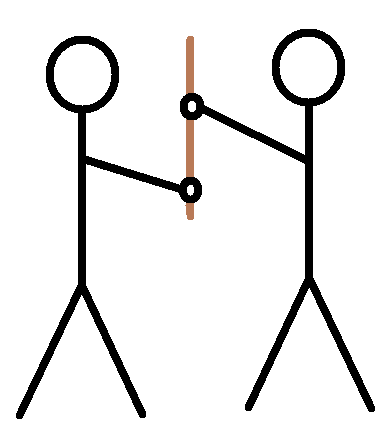Science concepts: torque, Newton’s 3rd law of motion
Seeing as how this past weekend I spent a whole day at a Hock SDMS (impact weapons) seminar, I figured that I’d write a little something relevant to that.
There are many aspects of physics that apply to stick fighting, but the first aspect of dealing with impact weapons that people should probably concern themselves with is blocking. Though I should note, that any knowledge about the optimal way to block with a stick will help you to prevent your opponent from blocking well (by making sure that those optimal conditions are not present for the other guy).
The Situation
Let’s assume, for the sake of simplicity, that both you and your opponent have sticks. Let’s also assume that your opponent has swung his stick at your head and that you cannot safely evade in time, which would be preferable to blocking. (We should also assume that you have offset your stick at a sufficient angle from the incoming strike so that the sticks aren’t parallel and bounce right past each other.) Where on your stick should you take the impact and why? Let’s look at the science.
The Science
At the moment of impact, we can treat the swinging motion of the opponent’s stick as a linear force. So we have a situation like the following:
 |
| ‘d’ is the distance from the impact force, F, to your hand, which is the thing providing the counter torque to prevent your block from collapsing |
The physic principle at work here is simple. The torque that your hand needs to provide to prevent the strike from collapsing is t = Fd. So, the greater the incoming force, the more torque you need to provide…no surprise there. And the greater the distance from your hand, the more torque you need to provide. So, the physics says to block as close to the hand as possible to minimize the torque necessary to complete the block. Now, for anyone who has done any amount of stick fighting knows just how unpleasant getting hit on the hand is (indeed there are plenty of people, myself included, that will actually aim for the hand). So, the physics have to weigh in against the psychological desire to avoid impact against the hand.
To improve your odds of success, using both hands is advisable. In fact, anyone who has done Hock’s “increasing 12” stick drill (which accumulates up to someone striking at you as hard as they can on 12 different angles of attack in a single combo) has probably decided that using the double-handed block is a good idea. You may think that putting two hands on the stick doubles your potential for getting your fingers crushed, but just try the “increasing 12” drill and see how you feel. With a two-handed grip, we end up with this:
Now, the second hand is providing additional “helper” torque for the first hand. The principle at work here is the same one used for building bridges. If you were to turn the above diagram 90 degrees counter-clockwise and ignore the fact that there’s a stick figure on the bottom, you’d basically have a force diagram for a car on a flat bridge.
The incoming force results in two reaction forces, one from each hand. Since torque can be calculated around any point, we can look at the torque at each hand individually. For the torque at the top hand, the reaction force at the bottom hand fights the torque of the incoming force. For the torque at the bottom hand, the reaction force of the top hand fights the torque of the incoming force. Two hands are better than one, clearly, but two-handed blocks are actually more than twice as easy as single-handed blocks. Why? Because instead of having to provide all the torque with the hand (the pinky side and the thumb side push the stick in opposite directions, basically), the torque is provided by two linear forces from the arms.
Think of it this way, when lifting heavy weight on a bench press would you use two hands for stability or just use one and let the tightness of the grip of the one hand stop the bar from rotating and dropping on either side?
Applications
Knowing this is not only great for helping your defense, it’s also great for helping your offense. If you strike in a way so that the other guy can, at best, get the tip of his stick in place for the block, then your strike has a higher chance of getting through. The same principle applies in the situation in which you grab your opponent’s stick. The applied force doesn’t necessarily have to come from your weapon. It can come from your hand. The closer your are to the tip of his stick, the easier it will be to manipulate.
Though for practical applications, you really want to grab about half-way up his stick so that when you punch it forward, the tip of his stick moves with even greater velocity (this is leverage and angular velocity at work). This balances the applied torque from your pushing hand and the leverage that multiplied the distance traveled by the tip of the stick versus your hand.
Conclusion
This material may be fairly intuitive, but it is also fundamental to understanding all stick blocking. The applications of this principle also extend to stick grappling, and there are even knife and unarmed applications from here too. You just need to think about it a bit and you’ll see it.

